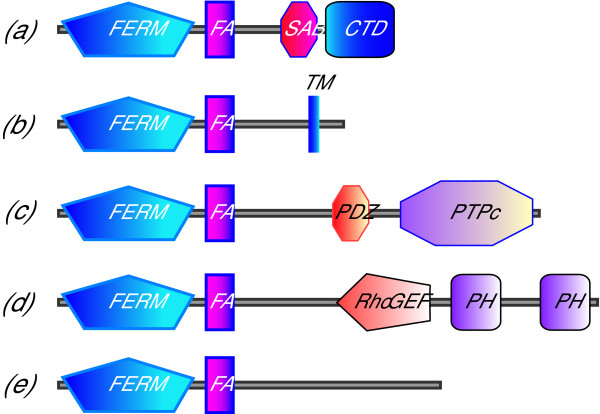Figure 2.

Examples of classes of proteins containing the FA region. The figure shows the modular organisation of FA region proteins in schematic outline. The proteins all contain FERM domains in their N-terminal region (although splice variation at certain N-termini can add extra sequence upstream of the FERM domain). On the C-terminal side of the FERM and FA regions are diverse sequences. Examples shown are as follows. (a) The true 4.1 proteins have a C-terminal domain (CTD) that binds receptors; and in mammals a spectrin-actin binding domain (SAB) promotes the binding of spectrin to actin. There are four such in vertebrate genomes, and one such in invertebrate genomes. (b) A group of poorly characterised proteins (two in vertebrate genomes, one in invertebrates) have FERM and FA regions, plus transmembrane segments in their C-terminal regions. They have no N-terminal signal sequences, and appear to be Type II membrane proteins. (c) The non-receptor tyrosine phosphatase protein PTP-MEG1 in mammals, PTP-MEG (split central complex) in fly and protein-tyrosine phosphatase 1 in worm are non-receptor tyrosine phosphatases localised at membranes; they have roles in control of cellular proliferation and control of interaction with extracellular matrix. Notably, the FA region was not found in the other FERM domain phosphatases PTPH1, PTP-E1 and PTP36. (d) CDEP is a GEF for Rho family GTPases. The FA region is also found in the related FARP2 gene product. (e) A variety of other proteins lack further domains recognised by SMART or Pfam. These include Band 4.1-like protein 5 and NBL-4.
